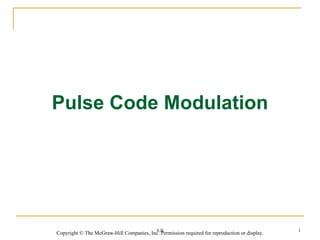
Pulse code mod
- 1. Pulse Code Modulation 4.# 1 Copyright © The McGraw-Hill Companies, Inc. Permission required for reproduction or display.
- 2. ANALOG-TO-DIGITAL CONVERSION A digital signal is superior to an analog signal because it is more robust to noise and can easily be recovered, corrected and amplified. For this reason, the tendency today is to change an analog signal to digital data. In this section we describe two techniques, pulse code modulation and delta modulation. Topics discussed in this section: Pulse Code Modulation (PCM) Delta Modulation (DM) 4.# 2
- 3. PCM PCM consists of three steps to digitize an analog signal: n Sampling n Quantization n Binary encoding Before we sample, we have to filter the signal to limit the maximum frequency of the signal as it affects the sampling rate. Filtering should ensure that we do not distort the signal, ie remove high frequency components that affect the signal shape. 4.# 3
- 4. Figure 4.21 Components of PCM encoder 4.# 4
- 5. Sampling Analog signal is sampled every TS secs. Ts is referred to as the sampling interval. fs = 1/Ts is called the sampling rate or sampling frequency. There are 3 sampling methods: Ideal - an impulse at each sampling instant Natural - a pulse of short width with varying amplitude Flattop - sample and hold, like natural but with single amplitude value The process is referred to as pulse amplitude modulation PAM and the outcome is a signal with analog (non integer) values 4.# 5
- 6. Figure 4.22 Three different sampling methods for PCM 4.# 6
- 7. Note According to the Nyquist theorem, the sampling rate must be at least 2 times the highest frequency contained in the signal. 4.# 7
- 8. Figure 4.23 Nyquist sampling rate for low-pass and bandpass signals 4.# 8
- 9. Example 4.6 For an intuitive example of the Nyquist theorem, let us sample a simple sine wave at three sampling rates: fs = 4f (2 times the Nyquist rate), fs = 2f (Nyquist rate), and fs = f (one-half the Nyquist rate). Figure 4.24 shows the sampling and the subsequent recovery of the signal. It can be seen that sampling at the Nyquist rate can create a good approximation of the original sine wave (part a). Oversampling in part b can also create the same approximation, but it is redundant and unnecessary. Sampling below the Nyquist rate (part c) does not produce a signal that looks like the original sine wave. 4.# 9
- 10. Figure 4.24 Recovery of a sampled sine wave for different sampling rates 4.# 10
- 11. Quantization Sampling results in a series of pulses of varying amplitude values ranging between two limits: a min and a max. The amplitude values are infinite between the two limits. We need to map the infinite amplitude values onto a finite set of known values. This is achieved by dividing the distance between min and max into L zones, each of height ∆. ∆ = (max - min)/L 4.# 11
- 12. Quantization Levels The midpoint of each zone is assigned a value from 0 to L-1 (resulting in L values) Each sample falling in a zone is then approximated to the value of the midpoint. 4.# 12
- 13. Quantization Zones Assume we have a voltage signal with amplitutes Vmin=-20V and Vmax=+20V. We want to use L=8 quantization levels. Zone width ∆ = (20 - -20)/8 = 5 The 8 zones are: -20 to -15, -15 to -10, -10 to -5, -5 to 0, 0 to +5, +5 to +10, +10 to +15, +15 to +20 The midpoints are: -17.5, -12.5, -7.5, -2.5, 2.5, 7.5, 12.5, 17.5 4.# 13
- 14. Assigning Codes to Zones Each zone is then assigned a binary code. The number of bits required to encode the zones, or the number of bits per sample as it is commonly referred to, is obtained as follows: nb = log2 L Given our example, nb = 3 The 8 zone (or level) codes are therefore: 000, 001, 010, 011, 100, 101, 110, and 111 Assigning codes to zones: 000 will refer to zone -20 to -15 001 to zone -15 to -10, etc. 4.# 14
- 15. Figure 4.26 Quantization and encoding of a sampled signal 4.# 15
- 16. Quantization Error When a signal is quantized, we introduce an error - the coded signal is an approximation of the actual amplitude value. The difference between actual and coded value (midpoint) is referred to as the quantization error. The more zones, the smaller ∆ which results in smaller errors. BUT, the more zones the more bits required to encode the samples -> higher bit rate 4.# 16
- 17. Bit rate and bandwidth requirements of PCM The bit rate of a PCM signal can be calculated form the number of bits per sample x the sampling rate Bit rate = nb x fs The bandwidth required to transmit this signal depends on the type of line encoding used. Refer to previous section for discussion and formulas. A digitized signal will always need more bandwidth than the original analog signal. Price we pay for robustness and other features of digital transmission. 4.# 17